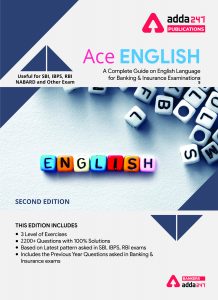Directions (1-5): Rearrange the given sentence (A), (B), (C), (D), (E) and (F) to form a meaningful paragraph and answer the questions that follow.
(A) Involuntary muscle jerks called myoclonus are common in both dogs and humans.
(B) And in humans, REM sleep has historically been associated with vivid dreaming.
(C) Animals’ sleeping lives have sparked human curiosity for thousands of years, but clear answers have been elusive.
(D) It’s the stage where you have the sort of weird, full-colour experiences you can’t wait to tell your family about over breakfast.
(F) That’s what you’re seeing when a dog’s limbs and paws quiver or move repeatedly during sleep.
(E) It’s most frequent during REM sleep and the flickering eyes, too, are associated with it.
Q1. Which of the following will be the FIRST sentence of the rearranged paragraph?
(a) F
(b) A
(c) C
(d) B
(e) D
Q2. Which of the following will be the LAST sentence of the rearranged paragraph?
(a) A
(b) C
(c) F
(d) E
(e) D
Q3. Which of the following will be the THIRD sentence of the rearranged paragraph?
(a) F
(b) D
(c) E
(d) A
(e) C
Q4. Which of the following will be the FIFTH sentence of the rearranged paragraph?
(a) A
(b) D
(c) F
(d) B
(e) E
Q5. What will be the correct sequence of the given sentences?
(a) DABFCE
(b) ADBCFE
(c) CAFEBD
(d) FDCEBA
(e) BDEFAC
Directions (6-10): Rearrange the given sentence (A), (B), (C), (D), (E) and (F) to form a meaningful paragraph and answer the questions that follow.
(A) They are trying to find out answers that can help them probe the potential of human settlement on the Red Planet, and what it might look like.
(B) Examples of such spacecraft missions are orbiters and rovers.
(C) However, the surface today is a cold desert. Scientists are exploring whether or not Mars can support life.
(D) In an attempt to investigate something that seems quite unrealistic, scientists have taken up several spacecraft missions related to the planet Mars.
(E) Around 3.6 to 3.0 billion years ago, Mars’ climate was at least occasionally warm enough for rivers and lakes. It was inferred to have been habitable.
(F) From Mariner 4 (1964) to Mars 2020 (2020), missions to Mars have unfolded several mysteries and produced remarkable findings.
Q6. Which of the following will be the FIRST sentence of the rearranged paragraph?
(a) A
(b) F
(c) E
(d) B
(e) C
Q7. Which of the following will be the LAST sentence of the rearranged paragraph?
(a) A
(b) C
(c) E
(d) D
(e) F
Q8. Which of the following will be the THIRD sentence of the rearranged paragraph?
(a) F
(b) D
(c) E
(d) A
(e) C
Q9. Which of the following will be the FIFTH sentence of the rearranged paragraph?
(a) E
(b) D
(c) F
(d) B
(e) C
Q10. What will be the correct sequence of the given sentences?
(a) ECADBF
(b) BDECFA
(c) DCBEFA
(d) BADFEC
(e) FCBAED
Directions (11-15): Rearrange the given sentence (A), (B), (C), (D) and (E) to forma meaningful paragraph and answer the questions that follow.
(A) Since the core is situated 1,800 miles (2,900km) below the Earth’s surface, it was assumed that the high-pressure environment and paucity of water-bearing minerals have protected the molten outer core from rust.
(B) A new study has said that the Earth’s core, which is composed of molten nickel and iron, is rusting.
(C) In the experiment, the scientists created high-pressure conditions that would exist in Earth’s core.
(D) But recent experiments suggested that rust can form at high pressures and could plausibly be formed at locations where water-rich slabs of Earth’s crust have sunk to the core-mantle boundary.
(E) Rusting happens when iron is exposed to moist air or oxygenated water, leading to a chemical reaction that leaves a reddish residue and making strong iron weak.
(F) The study was published in the journal Advancing Earth and Space Science.
Q11. Which of the following will be the FIRST sentence of the rearranged paragraph?
(a) F
(b) A
(c) B
(d) D
(e) C
Q12. Which of the following will be the LAST sentence of the rearranged paragraph?
(a) A
(b) C
(c) F
(d) B
(e) E
Q13. Which of the following will be the THIRD sentence of the rearranged paragraph?
(a) F
(b) D
(c) E
(d) B
(e) C
Q14. Which of the following will be the FIFTH sentence of the rearranged paragraph?
(a) C
(b) D
(c) B
(d) E
(e) A
Q15. What will be the correct sequence of the given sentences?
(a) ACFDEB
(b) FABDCE
(c) CBEDAF
(d) BFEADC
(e) EDBCAF
Solutions
S1. Ans. (c)
Sol. The correct sequence is CAFEBD.
(C) Animals’ sleeping lives have sparked human curiosity for thousands of years, but clear answers have been elusive.
(A) Involuntary muscle jerks called myoclonus are common in both dogs and humans.
(F) That’s what you’re seeing when a dog’s limbs and paws quiver or move repeatedly during sleep.
(E) It’s most frequent during REM sleep and the flickering eyes, too, are associated with it.
(B) And in humans, REM sleep has historically been associated with vivid dreaming.
(D) It’s the stage where you have the sort of weird, full-colour experiences you can’t wait to tell your family about over breakfast.
S2. Ans. (e)
Sol. The correct sequence is CAFEBD.
(C) Animals’ sleeping lives have sparked human curiosity for thousands of years, but clear answers have been elusive.
(A) Involuntary muscle jerks called myoclonus are common in both dogs and humans.
(F) That’s what you’re seeing when a dog’s limbs and paws quiver or move repeatedly during sleep.
(E) It’s most frequent during REM sleep and the flickering eyes, too, are associated with it.
(B) And in humans, REM sleep has historically been associated with vivid dreaming.
(D) It’s the stage where you have the sort of weird, full-colour experiences you can’t wait to tell your family about over breakfast.
S3. Ans. (a)
Sol. The correct sequence is CAFEBD.
(C) Animals’ sleeping lives have sparked human curiosity for thousands of years, but clear answers have been elusive.
(A) Involuntary muscle jerks called myoclonus are common in both dogs and humans.
(F) That’s what you’re seeing when a dog’s limbs and paws quiver or move repeatedly during sleep.
(E) It’s most frequent during REM sleep and the flickering eyes, too, are associated with it.
(B) And in humans, REM sleep has historically been associated with vivid dreaming.
(D) It’s the stage where you have the sort of weird, full-colour experiences you can’t wait to tell your family about over breakfast.
S4. Ans. (d)
Sol. The correct sequence is CAFEBD.
(C) Animals’ sleeping lives have sparked human curiosity for thousands of years, but clear answers have been elusive.
(A) Involuntary muscle jerks called myoclonus are common in both dogs and humans.
(F) That’s what you’re seeing when a dog’s limbs and paws quiver or move repeatedly during sleep.
(E) It’s most frequent during REM sleep and the flickering eyes, too, are associated with it.
(B) And in humans, REM sleep has historically been associated with vivid dreaming.
(D) It’s the stage where you have the sort of weird, full-colour experiences you can’t wait to tell your family about over breakfast.
S5. Ans. (c)
Sol. The correct sequence is CAFEBD.
(C) Animals’ sleeping lives have sparked human curiosity for thousands of years, but clear answers have been elusive.
(A) Involuntary muscle jerks called myoclonus are common in both dogs and humans.
(F) That’s what you’re seeing when a dog’s limbs and paws quiver or move repeatedly during sleep.
(E) It’s most frequent during REM sleep and the flickering eyes, too, are associated with it.
(B) And in humans, REM sleep has historically been associated with vivid dreaming.
(D) It’s the stage where you have the sort of weird, full-colour experiences you can’t wait to tell your family about over breakfast.
S6. Ans. (c)
Sol. The correct sequence is ECADBF.
(E) Around 3.6 to 3.0 billion years ago, Mars’ climate was at least occasionally warm enough for rivers and lakes. It was inferred to have been habitable.
(C) However, the surface today is a cold desert and the scientists are exploring whether or not Mars can support life.
(A) They are trying to find out answers that can help them probe the potential of human settlement on the Red Planet, and what it might look like.
(D) In an attempt to investigate something that seems quite unrealistic, scientists have taken up several spacecraft missions related to the planet Mars.
(B) Examples of such spacecraft missions are orbiters and rovers.
(F) From Mariner 4 (1964) to Mars 2020 (2020), missions to Mars have unfolded several mysteries and produced remarkable findings.
S7. Ans. (e)
Sol. The correct sequence is ECADBF.
(E) Around 3.6 to 3.0 billion years ago, Mars’ climate was at least occasionally warm enough for rivers and lakes. It was inferred to have been habitable.
(C) However, the surface today is a cold desert and the scientists are exploring whether or not Mars can support life.
(A) They are trying to find out answers that can help them probe the potential of human settlement on the Red Planet, and what it might look like.
(D) In an attempt to investigate something that seems quite unrealistic, scientists have taken up several spacecraft missions related to the planet Mars.
(B) Examples of such spacecraft missions are orbiters and rovers.
(F) From Mariner 4 (1964) to Mars 2020 (2020), missions to Mars have unfolded several mysteries and produced remarkable findings.
S8. Ans. (d)
Sol. The correct sequence is ECADBF.
(E) Around 3.6 to 3.0 billion years ago, Mars’ climate was at least occasionally warm enough for rivers and lakes. It was inferred to have been habitable.
(C) However, the surface today is a cold desert and the scientists are exploring whether or not Mars can support life.
(A) They are trying to find out answers that can help them probe the potential of human settlement on the Red Planet, and what it might look like.
(D) In an attempt to investigate something that seems quite unrealistic, scientists have taken up several spacecraft missions related to the planet Mars.
(B) Examples of such spacecraft missions are orbiters and rovers.
(F) From Mariner 4 (1964) to Mars 2020 (2020), missions to Mars have unfolded several mysteries and produced remarkable findings.
S9. Ans. (d)
Sol. The correct sequence is ECADBF.
(E) Around 3.6 to 3.0 billion years ago, Mars’ climate was at least occasionally warm enough for rivers and lakes. It was inferred to have been habitable.
(C) However, the surface today is a cold desert and the scientists are exploring whether or not Mars can support life.
(A) They are trying to find out answers that can help them probe the potential of human settlement on the Red Planet, and what it might look like.
(D) In an attempt to investigate something that seems quite unrealistic, scientists have taken up several spacecraft missions related to the planet Mars.
(B) Examples of such spacecraft missions are orbiters and rovers.
(F) From Mariner 4 (1964) to Mars 2020 (2020), missions to Mars have unfolded several mysteries and produced remarkable findings.
S10. Ans. (a)
Sol. The correct sequence is ECADBF.
(E) Around 3.6 to 3.0 billion years ago, Mars’ climate was at least occasionally warm enough for rivers and lakes. It was inferred to have been habitable.
(C) However, the surface today is a cold desert and the scientists are exploring whether or not Mars can support life.
(A) They are trying to find out answers that can help them probe the potential of human settlement on the Red Planet, and what it might look like.
(D) In an attempt to investigate something that seems quite unrealistic, scientists have taken up several spacecraft missions related to the planet Mars.
(B) Examples of such spacecraft missions are orbiters and rovers.
(F) From Mariner 4 (1964) to Mars 2020 (2020), missions to Mars have unfolded several mysteries and produced remarkable findings.
S11. Ans. (c)
Sol. The correct sequence is BFEADC.
(B) A new study has said that the Earth’s core, which is composed of molten nickel and iron, is rusting.
(F) The study was published in the journal Advancing Earth and Space Science.
(E) Rusting happens when iron is exposed to moist air or oxygenated water, leading to a chemical reaction that leaves a reddish residue and making strong iron weak.
(A) Since the core is situated 1,800 miles (2,900km) below the Earth’s surface, it was assumed that the high-pressure environment and paucity of water-bearing minerals have protected the molten outer core from rust.
(D) But recent experiments suggested that rust can form at high pressures and could plausibly be formed at locations where water-rich slabs of Earth’s crust have sunk to the core-mantle boundary.
(C) In the experiment, the scientists created high-pressure conditions that would exist in Earth’s core.
S12. Ans. (b)
Sol. The correct sequence is BFEADC.
(B) A new study has said that the Earth’s core, which is composed of molten nickel and iron, is rusting.
(F) The study was published in the journal Advancing Earth and Space Science.
(E) Rusting happens when iron is exposed to moist air or oxygenated water, leading to a chemical reaction that leaves a reddish residue and making strong iron weak.
(A) Since the core is situated 1,800 miles (2,900km) below the Earth’s surface, it was assumed that the high-pressure environment and paucity of water-bearing minerals have protected the molten outer core from rust.
(D) But recent experiments suggested that rust can form at high pressures and could plausibly be formed at locations where water-rich slabs of Earth’s crust have sunk to the core-mantle boundary.
(C) In the experiment, the scientists created high-pressure conditions that would exist in Earth’s core.
S13. Ans. (c)
Sol. The correct sequence is BFEADC.
(B) A new study has said that the Earth’s core, which is composed of molten nickel and iron, is rusting.
(F) The study was published in the journal Advancing Earth and Space Science.
(E) Rusting happens when iron is exposed to moist air or oxygenated water, leading to a chemical reaction that leaves a reddish residue and making strong iron weak.
(A) Since the core is situated 1,800 miles (2,900km) below the Earth’s surface, it was assumed that the high-pressure environment and paucity of water-bearing minerals have protected the molten outer core from rust.
(D) But recent experiments suggested that rust can form at high pressures and could plausibly be formed at locations where water-rich slabs of Earth’s crust have sunk to the core-mantle boundary.
(C) In the experiment, the scientists created high-pressure conditions that would exist in Earth’s core.
S14. Ans. (b)
Sol. The correct sequence is BFEADC.
(B) A new study has said that the Earth’s core, which is composed of molten nickel and iron, is rusting.
(F) The study was published in the journal Advancing Earth and Space Science.
(E) Rusting happens when iron is exposed to moist air or oxygenated water, leading to a chemical reaction that leaves a reddish residue and making strong iron weak.
(A) Since the core is situated 1,800 miles (2,900km) below the Earth’s surface, it was assumed that the high-pressure environment and paucity of water-bearing minerals have protected the molten outer core from rust.
(D) But recent experiments suggested that rust can form at high pressures and could plausibly be formed at locations where water-rich slabs of Earth’s crust have sunk to the core-mantle boundary.
(C) In the experiment, the scientists created high-pressure conditions that would exist in Earth’s core.
S15. Ans. (d)
Sol. The correct sequence is BFEADC.
(B) A new study has said that the Earth’s core, which is composed of molten nickel and iron, is rusting.
(F) The study was published in the journal Advancing Earth and Space Science.
(E) Rusting happens when iron is exposed to moist air or oxygenated water, leading to a chemical reaction that leaves a reddish residue and making strong iron weak.
(A) Since the core is situated 1,800 miles (2,900km) below the Earth’s surface, it was assumed that the high-pressure environment and paucity of water-bearing minerals have protected the molten outer core from rust.
(D) But recent experiments suggested that rust can form at high pressures and could plausibly be formed at locations where water-rich slabs of Earth’s crust have sunk to the core-mantle boundary.
(C) In the experiment, the scientists created high-pressure conditions that would exist in Earth’s core.





 GA Capsule for SBI Clerk Mains 2025, Dow...
GA Capsule for SBI Clerk Mains 2025, Dow...
 The Hindu Review October 2022: Download ...
The Hindu Review October 2022: Download ...
 Delhi CSIR CRRI Recruitment 2025 Notific...
Delhi CSIR CRRI Recruitment 2025 Notific...







